London Disabled Access Review
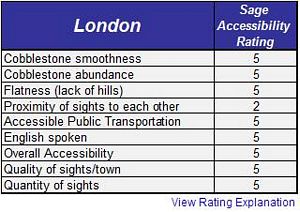 By John Sage
By John Sage
London disabled access is very good compared to other European cities making it one of the best destinations in Europe for disabled tourists. Getting around London in a wheelchair is easy compared to other popular destinations such as Paris and Rome, primarily because every taxi in London has a wheelchair ramp. Most of the buses also have wheelchair ramps, however few of the metro stations have elevators. UK disabled access building codes have resulted in most tourist attraction being accessible to wheelchair users.
London Disabled Access – Best Aspects
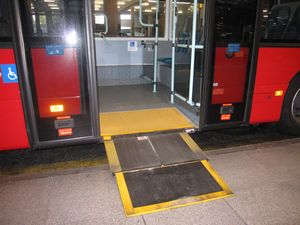
Accessible buses – Nearly all of the bus lines have buses with wheelchair ramps (example shown in the picture on the right). The ramps aren’t operational 100% of the time but they work more often than in other European cities. They do a fair job of connecting the tourist attractions and are a great way to save some money on your trip to London.
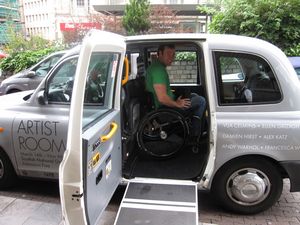 Accessible black cabs – The best aspect of London wheelchair access is that every taxi has a wheelchair ramp that the driver can extend to the curb (shown in the photo on the right). The ramp leads to a large flat area in between the front seats and the rear seats. The older cabs have a little lower head room than the new cabs, so electric wheelchair users may want to concentrate on hailing the newer cabs.
Accessible black cabs – The best aspect of London wheelchair access is that every taxi has a wheelchair ramp that the driver can extend to the curb (shown in the photo on the right). The ramp leads to a large flat area in between the front seats and the rear seats. The older cabs have a little lower head room than the new cabs, so electric wheelchair users may want to concentrate on hailing the newer cabs.
Major sights are wheelchair friendly – London tourist attractions generally have good disabled access relative to other European destinations. Almost all of the museums have a wheelchair accessible entrance (although it might not be the main entrance), and the same can be said for popular churches like St. Paul’s and Westminster Abbey. The gravel at Buckingham Palace and the steep ramp at Parliament cause some challenges but there is step-free access. Even the London Eye is accessible to wheelchair users and other disabled tourists by stopping the rotation and putting out a wheelchair ramp.
Flat London – Wheelchair users will appreciate the fact that almost all of the tourist areas of London are flat including Trafalgar Square, the theatre district, the area near the British Museum, and the south side of the Thames River near the Tate Modern and Imperial War Museum. The main exception is in the City of London near the Thames River and the Tower of London.
Very few cobblestones – The Battle of Britain during World War II resulted in a large number of bombs landing in London. Consequently, the city had to pretty much be rebuilt, and they did it with lots of pavement. Wheelchair tourists will enjoy the fact that there are very few cobblestones in London.
UK Accessibility Standards – UK building accessibility standards are quite good compared to many other countries in Europe. You will generally have a much easier time finding truly accessible London hotels and most tourist attractions are wheelchair friendly. Many of the historical buildings have wheelchair ramps or wheelchair lifts installed which is unlike disabled access in Paris.
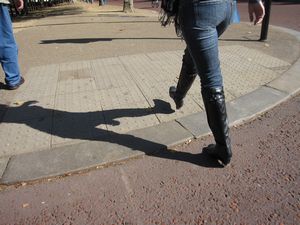 Curb cuts and sidewalks – Accessibility on London sidewalks is generally very good. The sidewalks are well-maintained and wheelchair users will not encounter much broken concrete. Most street intersections have curb cuts for wheelchair users.
Curb cuts and sidewalks – Accessibility on London sidewalks is generally very good. The sidewalks are well-maintained and wheelchair users will not encounter much broken concrete. Most street intersections have curb cuts for wheelchair users.
No language barrier – Disabled travelers need to communicate their needs more frequently than normal travelers which can be a problem in non-English speaking countries in continental Europe. Disabled visitors to London who speak English will not have this problem and will benefit from no language barrier.
Plenty to see – London has a wealth of museums, historical buildings, churches, and other attractions. There are easily two weeks worth of attractions to see inside London and by day trips to Bath, Stonehenge, and Windsor. Disabled visitors can spend an entire vacation here without having to move between cities and switch hotels.
London Disabled Access – Most Challenging Aspects
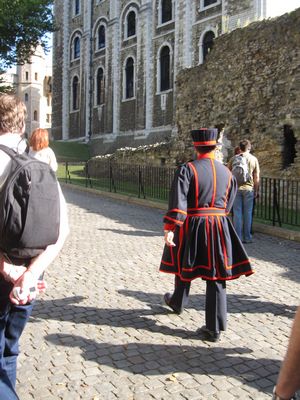 Tower of London cobblestones – The largest concentration of cobblestones in London is found at the Tower of London. Several of the historical buildings have steps with no ramps to enter. The building holding the crown jewels is wheelchair accessible, but tourists in wheelchair will have to roll over 200 meters of cobblestones to reach it.
Tower of London cobblestones – The largest concentration of cobblestones in London is found at the Tower of London. Several of the historical buildings have steps with no ramps to enter. The building holding the crown jewels is wheelchair accessible, but tourists in wheelchair will have to roll over 200 meters of cobblestones to reach it.
Spread out – While some London tourist attractions are near each other (for example, Parliament, Westminster Abbey, the Cabinet War Rooms, and the London Eye), many tourist attractions are spread out. It is 10 km (6 miles) from the Tower of London to the east to Kensington Palace in the west. Disabled tourists will need to use public transportation or taxis to get around the city.
Expensive accessible accommodation – London is an expensive city, particularly if you want a hotel within walking/rolling distance of the major tourist attractions and in the most charming neighborhoods.
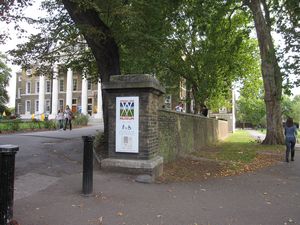 Need to find the side entrance – At many of the tourist attractions in London, you’ll need to locate an accessible side entrance to get in the building. The accessible London tourist attractions are better than those in other European cities about putting out signs directing you to it.
Need to find the side entrance – At many of the tourist attractions in London, you’ll need to locate an accessible side entrance to get in the building. The accessible London tourist attractions are better than those in other European cities about putting out signs directing you to it.
Opening times of tourist sites – Parliament and Buckingham Palace are great attractions, but only open during certain parts of the year. The changing of the guard at Buckingham Palace occurs every other day during certain times of the year and less frequently during other parts of the year.
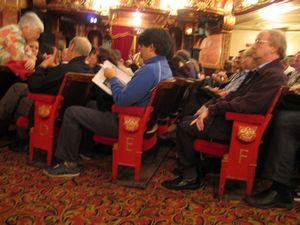 Theatre accessibility – Many of the theatres in London are very old and barely accessible. Disabled visitors will need to confirm that the individual theatre meets their accessibility needs.
Theatre accessibility – Many of the theatres in London are very old and barely accessible. Disabled visitors will need to confirm that the individual theatre meets their accessibility needs.
Accessible transportation from Heathrow airport – There is no London accessible public transportation that goes from Heathrow airport to the centre of London. You’ll need to take the Heathrow Express train to Paddington Station, then transfer to one of the accessible bus lines to get to your hotel.
Want a 100% Accessible Vacation?
View our London Accessible Travel Packages
Read more:
London Accessible Travel – main page
Pros and Cons of London Disabled Access
13 Wheelchair Accessible Travel Tips for London England
9 Keys to Success for London Handicapped Travel
Tower of London Wheelchair Access
London Eye Wheelchair Accessibility
Stonehenge Disabled Access
Travel Insurance for Disabled Travelers
London Accessible Travel Packages
Accessible Walking and Driving Tours in London
Highlights of London Accessible Driving Tour
Classic London Wheelchair Accessible Tour
Royal London Accessible Guided Tour
London Accessible Boat Cruise on the Thames River
Stonehenge & Hampton Court Accessible Driving Tour
Stonehenge & Windsor Castle Accessible Guided Tour
Stonehenge Accessible Tour by Train
Cambridge Accessible Tour from London
Oxford Accessible Tour from London
Highlights of Greenwich Accessible Tour
London Accessible Hotels
London Accessibility Guide by John Sage
London Trip Planning by Sage Traveling – Travel with Ease!
Contact our London accessible travel consultants


